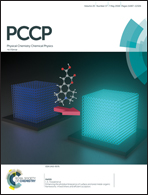From plasmon-induced luminescence enhancement in gold nanorods to plasmon-induced luminescence turn-off: a way to control reshaping†
Abstract
Two-photon luminescence (TPL) turn-off in small single gold nanorods (GNRs) exposed to increased resonant femtosecond laser excitation (800 nm wavelength, pulse energy density varying from 125 μJ cm−2 to 2.5 mJ cm−2) is investigated. The origin is shown to be a photo-induced decrease of the rod aspect ratio. This aspect ratio reduction could reasonably be assigned to gold atom diffusion away from the rod tips, where hot spots are localized. The two-photon luminescence signal can be recovered after a blue-shift of the incident excitation wavelength. No change in the excitation wavelength results in an out of resonance excitation of the rods and thus a reduced absorption, acting as feedback to stabilize the GNR shape and size. A theoretical analysis is presented evidencing limited thermal effects in the femtosecond regime for small nanoparticles, in good agreement with complementary topographic characterizations using scanning electron microscopy (SEM) and atomic force microscopy (AFM). We show finally that TPL reveals itself as a highly sensitive tool to follow tiny changes resulting from the photo-induced reshaping of GNRs.



 Please wait while we load your content...
Please wait while we load your content...